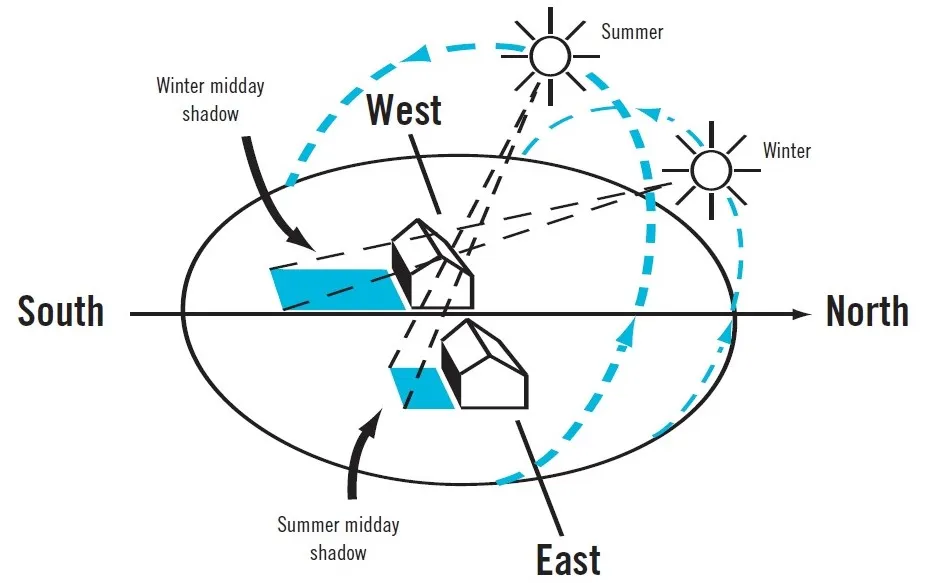If you want to know about the methods for reducing cost in design or site analysis or principles of design, please click the link.
Designing an energy efficient home is becoming increasingly important as people look to reduce their carbon footprint and save on energy costs. Here are some key elements to consider when designing an energy efficient home:
Using energy efficiency principles when designing your home will help you live more comfortably and save money!
An Energy Smart home takes advantage of the sun’s free warmth and light, with simple design features to keep it warm and comfortable in winter, and cool in summer.
1) Choosing a block (Orientation)
The way a home faces can have a big impact on its energy efficiency. A home that is oriented to the south can take advantage of passive solar heating in the winter, while shading from trees or other structures can protect it from overheating in the summer.

- Existing and planned blocks which have unobstructed solar access to the building envelope and private open space are best, especially in mid-winter when the sun angle is at its lowest.
2) Consider your climate
- Climate, geological and geographical conditions will influence the site plan and choice of building design and materials.
3) Internal planning & room placement
- Locate living areas, such as the family room, kitchen, lounge and dining room to the north of your home.
- Create zones by grouping rooms with similar uses together, separated by doorways.
- Avoid open plan living areas or high ceilings as these can lead to high heating costs. Maximum ceiling height should be 2.7 metres.
4) Building materials
The materials used in the construction of a home can also have an impact on its energy efficiency. Consider using materials with high thermal mass, such as brick, concrete, or stone, to help regulate temperature inside the home.
- Concrete floors and masonry walls can stabilize internal temperatures in rooms with a north-facing window by providing thermal mass to absorb heat transfer throughout summer and winter.
- Lightweight materials, such as timber or plasterboard, used internally will allow rooms to heat up and cool down quickly – useful for rooms which require occasional heating, or in tropical climates where the house is cooled by opening doors and windows.
- These materials are also good for sloping sites, to reduce the need for ‘cut and fill’ in ‘slab-on-ground’ construction.
5) Window placement & sizing
Energy-efficient windows can help reduce heat loss in the winter and heat gain in the summer. Look for windows with low-e coatings, multiple panes, and high-quality seals.

- Cross ventilation from cooling summer breezes can be achieved through well-positioned windows that can be opened.
- Double hung, casement or sliding windows are more effective than awning units. Try to keep short, direct paths between windows.
6) Window protection
i) Summer shading
External shading devices are a very effective way of keeping your house cool.
- North, east and west-facing windows should be shaded from the sun by vertical shading devices.
- North-facing windows can also be shaded by suitably designed eaves or pergolas that provide shade from the summer sun whilst providing access to the winter sun.
ii) Winter protection
- Heat losses can be cut by using high performance windows, or close-fitting drapes or blinds that trap a layer of insulating still air between them and the glass when closed.
- Pelmets are usually required.
7) Insulation
Proper insulation is crucial for maintaining a comfortable temperature inside the home and reducing the amount of energy needed for heating and cooling. Consider using high-performance insulation materials such as fiberglass, cellulose, or spray foam insulation.
- Insulation is the single most effective item you can add to your home to improve its thermal efficiency. It will keep you up to 7ºC cooler in summer and 10ºC warmer in winter.
- Insulate in the roof, ceiling, walls and suspended floors to levels appropriate for climatic and geographic conditions.
- Use reflective foil (sarking) to minimize summer heat gain.
- Consider insulating slab edges in cold climates.
8) Heating system
High-efficiency heating, ventilation, and air conditioning (HVAC) systems can significantly reduce energy consumption. Consider installing a programmable thermostat to help regulate the temperature inside your home and lower your energy bills.

- Having the flexibility to heat individual zones of the home with energy efficient heaters is the key to a comfortable, cost-effective system.
9) Lighting
Energy-efficient lighting, such as LED bulbs, can significantly reduce energy consumption. Consider installing dimmer switches, occupancy sensors, and timers to further increase efficiency.
- Make good use of natural light in living areas (particularly from north-facing windows). Light colored walls and ceilings will help.
- Use compact fluorescent lights in living areas. Install separate switches for each light.
10) Hot water
Energy-efficient homes should also include elements that promote water conservation, such as low-flow showerheads, toilets, and faucets.
- Install an energy efficient solar, gas or heat pump hot water system as near as possible to the kitchen, bathroom and laundry.
- Insulate hot water pipes, use efficient appliances, AAA rated showerheads and other water saving devices.
- Consider using a gas boosted solar system. These systems will reduce greenhouse gas emissions by over 75% when compared to a standard electric off-peak system and will cost less to run.
11) Landscaping
- Deciduous trees or native trees with a high canopy on the north side of the home allow the entry of sunlight in winter and provide shade in summer (take care to choose trees that will not block sun to or drop-leaf litter on solar collectors).
- Vegetation can be used to filter warm summer breezes.
12) Renewable energy systems
- Renewable energy systems, such as solar panels, can help reduce dependence on non-renewable energy sources and lower energy bills.
Here are a few more elements to consider when designing an energy-efficient home:
- Passive cooling and heating: Passive cooling and heating techniques can help reduce the amount of energy needed to regulate the temperature inside your home. For example, using natural ventilation, such as opening windows, can help cool your home in the summer.
- Rainwater harvesting: Installing a rainwater harvesting system can help reduce the amount of water used for irrigation and other non-potable uses.
- Smart home technology: Smart home technology, such as smart thermostats and smart lighting systems, can help you manage and monitor your home’s energy usage, making it easier to identify areas where you can improve efficiency.
- Green roof and wall: Green roofs and walls, which are covered with vegetation, can help reduce the amount of energy needed to regulate the temperature inside your home, as well as provide numerous environmental benefits, such as improving air quality and providing habitats for wildlife.
- Solar shading: Installing shading devices, such as exterior blinds or shading screens, can help reduce heat gain in the summer and improve thermal comfort inside the home.
By incorporating these elements into your home design, you can help create an energy-efficient home that is both environmentally friendly and cost-effective.